Submitted:
20 May 2024
Posted:
20 May 2024
You are already at the latest version
Abstract
Keywords:
1. Introduction
2. Materials and Methods
2.1. Study Area
2.2. Data acquisition and processing
2.3. Analysis methods and techniques
3. Results
3.1. Land Cover/Land Use Changes (LCLUC)
3.2. Evaluation of the forest dynamics
3.3. Building density and distribution by altitude
3.4. Biocultural resilience index (BRI)
4. Discussion and Conclusions
5. Future Research Trends
6. Methodological Limitations
Author Contributions
Funding
Conflicts of Interest
References
- Cusens, J., Barraclough, A.M.D., Måren, I.E. Participatory mapping reveals biocultural and nature values in the shared landscape of a Nordic UNESCO Biosphere Reserve. People and Nature 2022, 4, 365-381. https://doi.org/10.1002/pan3.10287. [CrossRef]
- Polce, C., Maes, J., Brander, L., Cescatti, A., Baranzelli, C., Lavalle, C, Zulian, G. Global change impacts on ecosystem services: a spatially explicit assessment for Europe. One Ecosystem 1: e9990 2016. https://doi.org/10.3897/oneeco.1.e9990. [CrossRef]
- Ruckelshaus, M.H., Jackson, S.T., Mooney, H.A., Jacobs, K.L., Kassam, K.-A.S., Arroyo, M.T.K., Báldi, A., Bartuska, A.M., Boyd, J., Joppa, L.N., Kovács-Hostyánszki, A., Parsons, J.P., Scholes, R.J., Shogren, J.F., Ouyang, Z. The IPBES global assessment: pathways to action. Trends in Ecology & Evolution 2020, 35(5), 407-414. [CrossRef]
- Nowak-Olejnik, A., Schirpke, U., Tappeiner, U. A systematic review on subjective well-being benefits associated with cultural ecosystem services. Ecosystem Services 2022, 57, 101467. [CrossRef]
- Lausch, A., Erasmi, S., King, D.J., Magdon, P., Heurich, M. Understanding forest health with remote sensing-part I-a review of spectral traits, processes and remote-sensing characteristics. Remote Sensing 2016, 8(12), 1029.
- Djomo, A.N., Grant, J.A., Fonyikeh-Bomboh Lucha, C., Tchoko Gagoe, J., Fonton, N.H., Scott, N., Sonwa, D.J. Forest governance and REDD+ in Central Africa: towards a participatory model to increase stakeholder involvement in carbon markets. International Journal of Environmental Studies 2018, 75(2), 251-266. [CrossRef]
- Seidl, R., Turner, M.G. Post-disturbance reorganization of forest ecosystems in a changing world. Proceedings of the National Academy of Sciences 2022, 119(28), e2202190119. [CrossRef]
- Krankina, O.N., Harmon, M.E., Winjum, J.K. Carbon storage and sequestration in the Russian forest sector. AMBIO-STOCKHOLM 1996, 25, 284-288.
- Luo, Y., Chen, H.Y. Observations from old forests underestimate climate change effects on tree mortality. Nature communications 2013, 4(1), 1655. [CrossRef]
- Hadziabdic, D., Hamelin, R.C., Stewart, J.E., Villari, C. Forest pathology in changing climate. Frontiers in Forests and Global Change 2022, 5, 1032035.
- Cozma, A.C., Coroș, M.M., Pop, A. M., Gavrilescu, I., Dinucă, N.C. Corruption, deforestation, and tourism - Europe case study. Heliyon 2023, 9(8). https://doi.org/10.1016/j.heliyon.2023.e19075. [CrossRef]
- Führer, E. Forest functions, ecosystem stability and management. Forest Ecology and management 2000, 132(1), 29-38. [CrossRef]
- Jebiwott, A., Ogendi, G.M., Agbeja, B.O., Alo, A.A., Kibet, R. Mapping the trends of forest cover change and associated drivers in Mau Forest, Kenya. Remote Sensing Applications: Society and Environment 2021, 23, 100586. [CrossRef]
- Brandt, J. Demands for future landscapes research on multifunctional landscapes. In Proceedings of the Conference on Multifunctional Landscapes-Interdisciplinary Approaches to Landscape Research and Management. Roskilde, October 2000 (pp. 18-21).
- Van Eetvelde, V., Antrop, M. Analyzing structural and functional changes of traditional landscapes-two examples from Southern France. Landscape and urban planning 2004, 67(1-4), 79-95.
- Farina, A. The cultural landscape as a model for the integration of ecology and economics. BioScience 2000, 50(4), 313-320. [CrossRef]
- Ellis, E.C. Ecology in an anthropogenic biosphere. Ecological Monographs 2015, 85(3), 287-331. [CrossRef]
- Plieninger, T., Draux, H., Fagerholm, N., Bieling, C., Bürgi, M., Kizos, T., Kuemmerle, T., Primdahl, J., Verburg, P.H. The driving forces of landscape change in Europe: A systematic review of the evidence. Land Use Policy 2016, 57, 204-214. https://doi.org/10.1016/j.landusepol.2016.04.040. [CrossRef]
- Wu, J. Key concepts and research topics in landscape ecology revisited: 30 years after the Allerton Park workshop. Landscape ecology 2013, 28, 1-11. [CrossRef]
- Ianăş, A.N., Germain, D. Quantifying landscape changes and fragmentation in a National Park in the Romanian Carpathians. Carpathian Journal of Earth and Environmental Sciences 2018, 13(1): 147-160. [CrossRef]
- Forman, R. T. Ecologically sustainable landscapes: the role of spatial configuration. In Changing landscapes: an ecological perspective (pp. 261-278). New York, NY: Springer New York, 1990.
- Wu, J. Landscape ecology, cross-disciplinarity, and sustainability science. Landscape ecology 2006, 21, 1-4.
- Forman, R. T. The urban region: natural systems in our place, our nourishment, our home range, our future. Landscape Ecology 2008, 23, 251-253. [CrossRef]
- Pătru-Stupariu, I., Stupariu, M.S, Tudor, C.A., Grădinaru, S.R., Gavrilidis A., Kienast, F., Hersperger A.M. Landscape fragmentation in Romania’s Southern Carpathians: testing a European assessment with local data. Landscape and Urban Planning 2015, 143, 1-8. [CrossRef]
- Wilson, G.A., Multifunctional Agriculture-A Transition Theory Perspective; CABI: Oxfordshire, UK, 2007.
- Vejre, H., Abildtrup, J., Andersen, E., Andersen, P.S., Brandt, J., Busck, A., Dalgaard, T., Hasler, B., Huusom, H., Kristensen, L.S., Kristensen, S.P., Præstholm, S. Multifunctional Agriculture and Multifunctional Landscapes-Land Use as an Interface. In Multifunctional Land Use: Meeting Future Demands for Landscape Goods and Services; Mander, Ü., Wiggering, H., Helming, K., Eds.; Springer: Berlin/Heidelberg, Germany; pp. 93-104. 2007. ISBN 978-3-540-36763-5.
- Peng, J., Hu, X., Qiu, S., Meersmans, J., Liu, Y. Multifunctional landscapes identification and associated development zoning in mountainous area. Science of the Total Environment 2019, 660, 765-775. [CrossRef]
- Cimpoca, A.-L., Voiculescu, M., Crețan, R., Voiculescu, S., Ianăș, A.-N. Living with Bears in Prahova Valley, Romania: An Integrative Analysis. Animals 2024, 14, 587. https://doi.org/10.3390/ani14040587. [CrossRef]
- Blumetto, O., Castagna, A., Cardozo, G., Ruggia, A., Scarlato, G.T., Garcia, F., Aguerre, V. (2016). Ecosystem Integrity Index: A New Tool for Ecosystem Services Evaluation in Livestock Production Systems, The Future Management of Grazing and Wild Lands in a High-Tech World. In Proceedings of the 10th International Rangeland Congress. Canada, 2016, 448-449.
- O’Farrell, P.J., Anderson, P.M. Sustainable multifunctional landscapes: a review to implementation. Current Opinion in Environmental Sustainability 2010. 2(1-2), 59-65. [CrossRef]
- Fagerholm, N., Torralba, M., Moreno, G., Girardello, M., Herzog, F., Aviron, S., Burgess, P., Crous-Duran, J., Ferreiro-Domínguez, N., Graves, A., Hartel, T., Măcicăsan, V., Kay, S., Pantera, A., Varga, A., Plieninger, T. Cross-site analysis of perceived ecosystem service benefits in multi-functional landscapes. Glob. Environ. Chang 2019, 56, 134–147.
- German, L. A., Karsenty, A., Tiani, A. M. (Eds.).Governing Africa's forests in a globalized world. Earthscan: London, UK, 2010.
- Jebiwott, A., Ogendi, G.M., Agbeja, B.O., Alo, A.A., Kibet, R. Mapping the trends of forest cover change and associated drivers in Mau Forest, Kenya. Remote Sensing Applications: Society and Environment 2021, 23, 100586.
- Oktan, E., Kezik, U., Hacisalihoglu, S., Yucesan, Z. Effects of Deforestation on Soil Erosion and Carbon Sequestration in the Soil. Fresenius Environ. Bull 2022, 31, 2239-2249.
- Corbera, E., Estrada, M., Brown, K. Reducing greenhouse gas emissions from deforestation and forest degradation in developing countries: revisiting the assumptions. Climatic change 2010, 100(3-4), 355-388. [CrossRef]
- Gauthier, S., Bernier, P., Kuuluvainen, T., Shvidenko, A.Z., Schepaschenko, D.G. Boreal forest health and global change. Science 2015, 349(6250), 819-822. [CrossRef]
- Fora, C.G., Balog, A. The effects of the management strategies on spruce bark beetles populations (Ips typographus and Pityogenes chalcographus), in Apuseni Natural Park, Romania. Forests 2021, 12(6), 760.
- Suorsa, P., Huhta, E., Nikula, A., Nikinmaa, M., Jäntti, A., Helle, H., Hakkarainen, H. Forest management is associated with physiological stress in an old-growth forest passerine. Proceedings of the Royal Society of London. Series B: Biological Sciences 2003, 270(1518), 963-969. [CrossRef]
- He, M., Cliquet, A. Challenges for protected areas management in China. Sustainability 2020, 12(15), 5879. [CrossRef]
- Acheson, J. M., McCloskey, J. Causes of deforestation: The Maine case. Human ecology 2008, 36, 909-922. [CrossRef]
- Rachmawan, I. E. W., Kiyoki, Y. Semantic analysis of deforestation soil effect using multispectral reflectance. In 2016 International Electronics Symposium (IES), September 2016, (pp. 363-368). IEEE.
- FAO (Food and Agriculture Organization), 2020 Global Forest Resources Assessment 2020 (Rome: FAO) (available at: https://doi.org/10.4060/ca8753en). [CrossRef]
- Houghton, R. A. Tropical deforestation as a source of greenhouse gas emissions. Tropical deforestation and climate change 2005, 13.
- Blackman, A. Evaluating forest conservation policies in developing countries using remote sensing data: An introduction and practical guide. Forest Policy and Economics 2013, 34, 1-16. [CrossRef]
- Strandberg, G., Kjellström, E., Poska, A., Wagner, S., Gaillard, M.-J., Trondman, A.-K., Mauri, A., Davis, B.A.S., Kaplan, J.O., Birks, H.J.B., Bjune, A.E., Fyfe, R., Giesecke, T., Kalnina, L., Kangur, M., Van Der Knaap, W.O., Kokfelt, U., Kuneš, P., Latałowa, M., Marquer, L., Mazier, F., Nielsen, A.B., Smith, B., Seppä, H., Sugita, S. Regional climate model simulations for Europe at 6 and 0.2 k BP: sensitivity to changes in anthropogenic deforestation. Climate of the Past 2014, 10, 661–680. https://doi.org/10.5194/cp-10-661-2014. [CrossRef]
- Yamamoto, Y., Matsumoto, K.I. The effect of forest certification on conservation and sustainable forest management. Journal of Cleaner Production 2022, 363, 132374. [CrossRef]
- Bradshaw, C.J., Sodhi, N.S., PEH, K.S.H., Brook, B.W. Global evidence that deforestation amplifies flood risk and severity in the developing world. Global Change Biology 2007, 13(11), 2379-2395. [CrossRef]
- Corbera, E., Estrada, M., Brown, K. Reducing greenhouse gas emissions from deforestation and forest degradation in developing countries: revisiting the assumptions. Climatic change 2010, 100(3-4), 355-388. [CrossRef]
- La Vina, A., de Leon, A.M. Two global challenges, one solution: international cooperation to combat climate change and tropical deforestation. Center for Global Development Working Paper 2014, (388).
- Baccini, A., Walker, W., Carvalho, L., Farina, M., Sulla-Menashe, D., Houghton, R.A. Tropical forests are a net carbon source based on aboveground measurements of gain and loss. Science 2017, 358(6360), 230-234. [CrossRef]
- Pendrill, F., Persson, U.M., Godar, J., Kastner, T. Deforestation displaced: trade in forest-risk commodities and the prospects for a global forest transition. Environmental Research Letters 2019, 14(5), 055003. https://doi.org/10.1088/1748-9326/ab0d41. [CrossRef]
- Swanson, M.E., Franklin, J.F., Beschta, R.L., Crisafulli, C.M., Dellasala, D.A., Hutto, R.L., Lindenmayer, D.B., Swanson, F.J. The forgotten stage of forest succession: early-successional ecosystems on forest sites. Frontiers in Ecology and the Environment 2011, 9, 117–125. https://doi.org/10.1890/090157. [CrossRef]
- Kuemmerle, T., Kaplan, J.O., Prishchepov, A.V., Rylsky, I., Chaskovskyy, O., Tikunov, V. S., Müller, D. Forest transitions in Eastern Europe and their effects on carbon budgets. Global change biology 2015, 21(8), 3049-3061. [CrossRef]
- Davin, E.L., Rechid, D., Breil, M., Cardoso, R.M., Coppola, E., Hoffmann, P., Jach, L.L., Katragkou, E., De Noblet-Ducoudré, N., Radtke, K., Raffa, M., Soares, P.M.M., Sofiadis, G., Strada, S., Strandberg, G., Tölle, M.H., Warrach-Sagi, K., Wulfmeyer, V. Biogeophysical impacts of forestation in Europe: first results from the LUCAS (Land Use and Climate Across Scales) regional climate model intercomparison. Earth System Dynamics 2020, 11(1), 183-200. https://doi.org/10.5194/esd-11-183-2020. [CrossRef]
- Hajabbasi, M.A., Jalalian, A., Karimzadeh, H.R. Deforestation effects on soil physical and chemical properties, Lordegan, Iran. Plant and soil 1997, 190, 301-308. [CrossRef]
- Falt’an, V.,Petrovic, F., Gábor, M., Šagát, V., Hruška, M. Mountain Landscape Dynamics after Large Wind and Bark Beetle Disasters and Subsequent Logging-Case Studies from the Carpathians. Remote Sens. 2021, 13, 3873. https://doi.org/ 10.3390/rs13193873. [CrossRef]
- Costea, A., Bilașco, Șt., Irimuș, I.-A., Roșca, S., Vescan, I., Fodorean, I., Sestraș, P., Evaluation of the Risk Induced by Soil Erosion on the Land Use. Case Study: Guruslău Depression. Sustainability 2022, 14(2), 652. https://doi.org/10.3390/su14020652. [CrossRef]
- Chomitz, K. M., Piet, B., Giacomo, D. L., Timothy, S.T., Sheila, W.K. At loggerheads? Agricultural expansion, poverty reduction and environment in the tropical forests. World Bank, Washington, D.C. 2007.
- Boțan, C.N., Gligor, V., Horvath, C., Fonogea, S.F. Land of Hațeg Identity and Regional Brands, Transylvanian Review 2019, Vol. XXVIII, Supplement No. 2, 183 – 198.
- Adorean, E.C., Nofre, J., Ilovan, O.-R., Gligor, V. Exploring nightlife in the university city of Cluj-Napoca (Romania): a mixed methods research study. Fennia 2020, 198(1-2), 180-195, https://doi.org/10.11143/fennia.90011. [CrossRef]
- Akumu, C.E., Amadi, E.O. Examining the Integration of Landsat Operational Land Imager with Sentinel-1 and Vegetation Indices in Mapping Southern Yellow Pines (Loblolly, Shortleaf, and Virginia Pines). Photogrammetric Engineering & Remote Sensing 2022, 88(1), 29–38. https://doi.org/10.14358/pers.21-00024r2. [CrossRef]
- Forkuo, E.K. Frimpong, A. Analysis of Forest Cover Change Detection. Int. J. Remote Sens. Appl. 2012, 2, 82–92.
- Miller, A.B., Bryant, E.S., Birnie, R.W. An analysis of land cover changes in the Northern Forest of New England using multitemporal Landsat MSS data. International journal of remote sensing 1998, 19(2), 245-265. [CrossRef]
- Cohen, W.B., Spies, T.A., Alig, R.J., Oetter, D.R., Maiersperger, T.K., Fiorella, M. Characterizing 23 years (1972–95) of stand replacement disturbance in western Oregon forests with Landsat imagery. Ecosystems 2002, 5, 122-137. [CrossRef]
- Yang, C., Huang, H., Han, S., Ni, J. Correlation analysis between forest volume and LANDSAT TM data based on sub-compartment objects. In 2013 IEEE International Geoscience and Remote Sensing Symposium-IGARSS July 2013, (pp. 1721-1724). IEEE.
- Jiao, Q., Zhang, X., Sun, Q. Detecting of forest afforestation and deforestation in Hainan Jianfengling Forest Park (China) using yearly Landsat time-series images. In MIPPR 2017: Remote Sensing Image Processing, Geographic Information Systems, and Other Applications March 2018 (Vol. 10611, pp. 311-315). SPIE.
- Blaga, L., Ilies, D.C., Wendt, J.A., Rus, I., Zhu, K., Dávid, L.D. Monitoring Forest Cover Dynamics Using Orthophotos and Satellite Imagery. Remote Sens 2023, 15, 3168. https://doi.org/10.3390/ rs15123168. [CrossRef]
- Wulder, M.A., Coops, N.C., Roy, D.P., White, J.C., Hermosilla, T. Land cover 2.0. International Journal of Remote Sensing 2018, 39 (12), 4254-4284. https://doi.org/10.1080/01431161.2018.1452075. [CrossRef]
- Roy, D.P., Yan, L. Robust Landsat-based crop time series modelling. Remote Sens. Environ. 2018, 238, 110810. [CrossRef]
- Rose, M.B., Nagle, N.N. Characterizing Forest Dynamics with Landsat-Derived Phenology Curves. Remote Sensing 2021, 13(2), 267. [CrossRef]
- Ni, G. Vegetation index and its advances. Journal of Arid Meteorology 2003, 21(4), 71.
- Bai, Y., Yang, Y., Jiang, H. Intercomparison of AVHRR GIMMS3g, terra MODIS, and SPOT-VGT NDVI products over the Mongolian plateau. Remote Sensing 2019, 11(17), 2030. [CrossRef]
- Costantini, M.L., Zaccarelli, N., Mandrone, S., Rossi, D., Calizza, E., Rossi, L. NDVI spatial pattern and the potential fragility of mixed forested areas in volcanic lake watersheds. Forest ecology and management 2012, 285, 133-141. [CrossRef]
- Wu, J. Key concepts and research topics in landscape ecology revisited: 30 years after the Allerton Park workshop. Landscape ecology 2013, 28, 1-11. [CrossRef]
- Silveira, E.M.D.O., Mello, J.M.D., Acerbi, F.W., Reis, A.A.D., Withey, K.D., Ruiz, L.A. Characterizing landscape spatial heterogeneity using semivariogram parameters derived from NDVI images. Cerne 2017, 23, 413-422.
- Zurlini, G., Riitters, K., Zaccarelli, N., Petrosillo, I., Jones, K.B., Rossi, L. Disturbance patterns in a socio-ecological system at multiple scales. Ecol. Complex. 2006, 3, 119–128. [CrossRef]
- Zaccarelli, N., Riitters, K.H., Petrosillo, I., Zurlini, G. Indicating disturbance content and context for preserved areas. Ecol. Indic. 2008, 8(6), 841-853. [CrossRef]
- Griffith, J.A., Martinko, E.A., Whistler, J.L., Price, K.P. Preliminary comparison of landscape pattern–normalized difference vegetation index (NDVI) relationships to Central Plains stream conditions. Journal of environmental quality 2002,31(3), 846-859.
- Agnoletti, M., Tredici, M., Santoro, A. Biocultural diversity and landscape patterns in three historical rural areas of Morocco, Cuba and Italy, Biodiversity and conservation 2015, 24, 3387-3404. https://doi.org/10.1007/s10531-015-1013-6. [CrossRef]
- Merçon, J., Vetter, S., Tengö, M., Cocks, M., Balvanera, P., Rosell, J.A., Ayala-Orozco, B. From local landscapes to international policy: contributions of the biocultural paradigm to global sustainability. Global Sustainability 2019, 2, e7. [CrossRef]
- Bridgewater, P., Rotherham, I.D. A critical perspective on the concept of biocultural diversity and its emerging role in nature and heritage conservation. People and Nature 2019, 1(3), 291-304. [CrossRef]
- Berkes, F., Ross, H. Community resilience: Toward an integrated approach. Society & natural resources 2013, 26(1), 5-20. https://doi.org/10.1080/08941920.2012.736605. [CrossRef]
- Engle, N.L., de Bremond, A., Malone, E.L., Moss, R.H. Towards a resilience indicator framework for making climate-change adaptation decisions. Mitigation and Adaptation Strategies for Global Change 2014, 19, 1295-1312. https://doi. org/10.1007/s11027-013-9475-x. [CrossRef]
- Ungar, M., McRuer, J., Liu, X., Theron, L., Blais, D., Schnurr, M.A. Social-ecological resilience through a biocultural lens: A participatory methodology to support global targets and local priorities. Ecol. Soc. 2020, 25, 8. [CrossRef]
- Bengtsson, J., Angelstam, P., Elmqvist, T., Emanuelsson, U., Folke, C., Ihse, M., Moberg, F. Nystrm, M. Reserves, resilience and dynamic landscapes 20 years later. Ambio 2021, 50, 962-966. https://doi.org/10.1007/s13280-020-01477-8. [CrossRef]
- Walker, B., Holling, C.S., Carpenter, S.R., Kinzig, A. Resilience, adaptability and transformability in social–ecological systems. Ecology and society 2004, 9(2). https://doi.org/10.5751/ ES-00650-090205. [CrossRef]
- Folke, C., Carpenter, S. R., Walker, B., Scheffer, M., Chapin, T., Rockström, J. Resilience thinking: integrating resilience, adaptability and transformability. Ecology and society 2010, 15(4). http://doi.org/10.5751/ES-03610-150420. [CrossRef]
- Bănică, A. Resilience and/or sustainable development? Avatars of sustainability. In Sustainable development and resilience. Territorial perspectives and multidisciplinary approaches. Bănică, A., Petrișor, A.I., Publishing House of the Romanian Academy, Bucharest, 2021.
- Quinlan, A.E., Berbés-Blázquez, M., Haider, L.J., Peterson, G.D. Measuring and assessing resilience: broadening understanding through multiple disciplinary perspectives. Journal of Applied Ecology 2016, 53(3), 677-687. [CrossRef]
- Olsson, P., Folke, C., Hahn, T. Social-ecological transformation for ecosystem management: the development of adaptive co-management of a wetland landscape in southern Sweden. Ecology and society 2004, 9(4). [CrossRef]
- Sterling, E., Ticktin, T., Morgan, T.K.K., Cullman, G., Alvira, D., Andrade, P., Bergamini, N., Betley, E., Burrows, K., Caillon, S. Culturally grounded indicators of resilience in social-ecological systems. Environ. Soc. 2017, 8, 63-95. [CrossRef]
- Berkes, F. Sacred Ecology: Traditional Ecological Knowledge and Resource Management. Third edition. Routledge: New York, 2012. [CrossRef]
- Gavin, M.C., McCarter, J., Mead, A., Berkes, F., Stepp, J.R., Peterson, D., Tang, R. Defining biocultural approaches to conservation. Trends in ecology & evolution 2015, 30(3), 140-145. [CrossRef]
- Sterling, E.J., Filardi, C., Toomey, A.; Sigouin, A., Betley, E., Gazit, N., Newell, J., Albert, S., Alvira, D., Bergamini, N. Biocultural approaches to well-being and sustainability indicators across scales. Nat. Ecol. Evol. 2017, 1, 1798–1806. [CrossRef]
- IUCN; WCMC. Guidelines for Protected Areas Management Categories; IUCN: Gland, Switzerland; CNPPA: Ambleside, UK; WCMC: Cambridge, UK, 1994.
- Strickland-Munro, J.K., Allison, H.E., Moore, S.A. Using resilience concepts to investigate the impacts of protected area tourism on communities. Annals of tourism research 2010, 37(2), 499-519. [CrossRef]
- Ribeiro, M.B.N., Verissimo, A. Patterns and causes of deforestation in protected areas of Rondonia-Brazil. Natureza & Conservação 2007, 5(1), 15-26.
- Cuenca, P., Arriagada, R., Echeverría, C. How much deforestation do protected areas avoid in tropical Andean landscapes?. Environmental Science & Policy 2016, 56, 56-66. [CrossRef]
- Vorovencii, I. Quantification of forest fragmentation in pre-and post-establishment periods, inside and around Apuseni Natural Park, Romania. Environmental monitoring and assessment 2018, 190, 1-15.
- Wade, C.M., Austin, K.G., Cajka, J., Lapidus, D., Everett, K.H., Galperin, D., Maynard, R., Sobel, A. What Is Threatening Forests in Protected Areas? A Global Assessment of Deforestation in Protected Areas, 2001-2018. Forests 2020, 11, 539. [CrossRef]
- Kroeker-Maus, D. The protected area as enclave: Towards new geographies of tourism and conservation. Geography Compass 2014, 8(11), 796-807. [CrossRef]
- Huggins, X., Gleeson, T., Serrano, D., Zipper, S., Jehn, F., Rohde, M.M., Abell, R., Vigerstol, K., Hartmann, A. Overlooked risks and opportunities in groundwatersheds of the world’s protected areas. Nat. Sustain. 2023, 6, 855-864. [CrossRef]
- Zielinska, A. Abilities of running an economic activity on protected areas. Economics & Sociology 2009, 2(2), 108. [CrossRef]
- Zmijanović, L. Measurements Of Protected Areas Management Efficiency. Ekonomski pregled 2019, 70(1), 62-86.
- Grodzki, W. Entomofauna of Dying Young Spruces Picea Abies (L.) Karst. in the Area after Forest Decline in the Izerskie Mountains. Folia For. Pol. Ser. A 2009, 51, 161–170. [CrossRef]
- Rouse, R.W.H., Haas, J.A.W., Deering, D.W. Monitoring Vegetation Systems in the Great Plains with ERTS. In Third Earth Resources Technology Satellite-1 Symposium-Volume I: Technical Presentations; NASA SP-351; NASA: Washington, DC, USA, 1974; pp. 309–317. https://ntrs.nasa.gov/citations/19740022614.
- Fusami, A.A., Nweze, O.C., Hassan, R. Comparing the Effect of Deforestation Result by NDVI and SAVI. Int. J. Sci. Res. Publ.(IJSRP) 2020, 10(6), 918-925. [CrossRef]
- Zaitunah, A., Samsuri, Sahara, F. Mapping and Assessment of Vegetation Cover Change and Species Variation in Medan, North Sumatra. Heliyon 2021, 7, e07637. https://doi.org/10.1016/j.heliyon.2021.e07637. [CrossRef]
- Hesselbarth, M.H.K., Sciaini, M., With, K.A., Wiegand, K., Nowosad, J. Landscapemetrics: an open-source R tool to calculate landscape metrics. Ecography 2019, 42 (10), 1648-1657. [CrossRef]
- Mustățea, M. Fragmentation and connectivity at landscape level from Carpathian mountains ecoregion - A synthesis. Bucov. For. 2021, 21(2), 199-216.
- Goepel, K.D. Implementation of an Online Software Tool for the Analytic Hierarchy Process (AHP-OS). International Journal of the Analytic Hierarchy Process 2018, 10 (3), pp 469-487. [CrossRef]
- Avădănei, V., Surdu, I., Medveschi, I., Cociș, E.-A., Păcurar, B.-N., Nicula, A.-S. Analysis of Discording Geodemographic Structures and Space Polarization in Regional Context Using GIS Technology: Case Study: Apuseni Mountains Romania. In L. Chivu, V. IoanFranc, G. Georgescu, & J.V. Andrei (Eds.), Romanian Economy. A Century of Transformation (1918-2018): Proceedings of ESPERA 2018 (pp. 1011-1022).
- Andronache, I., Marin, M., Fischer, R., Ahammer, H., Radulovic, M., Ciobotaru, A.-M., Jelinek, H.F., Di Ieva, A., Pintilii, R.-D., Drăghici, C.-C., Herman, G.V., Nicula, A.-S., Simion, A.-G., Loghin, I.-V., Diaconu, D.-C., Peptenatu, D., Dynamics of Forest Fragmentation and Connectivity Using Particle and Fractal Analysis. Sci Rep, 2019, 9, 12228. https://doi.org/10.1038/s41598-019-48277-z. [CrossRef]
- Nistor, Mărgărit & Nicula, Alexandru-Sabin & Cervi, Federico & Man, Titus & Ioan-Aurel, Irimus & Surdu, Ioan. Groundwater vulnerability gis models in the carpathian mountains under climate and land cover changes. Applied Ecology and Environmental Research, 2018, 16, 5095-5116. 10.15666/aeer/1604_50955116. [CrossRef]
- Nistor, M.M., Mîndrescu, M., Petrea, D., Nicula, A.S., Rai, P.K., Benzaghta, M.A., Dezsi, Ş., Hognogi, G., Porumb-Ghiurco, C.G. Climate change impact on crop evapotranspiration in Turkey during the 21st Century. Meteorological Applications, 2019, 26(3), 442-453. [CrossRef]
- Ilovan, O.R., Dulamă, M.E., Boțan, C.N., Havadi-Nagy, K.X., Horvath, C., Nițoaia, A., Nicula, S., Rus, G.M. Environmental education and education for sustainable development in Romania. Teachers' perceptions and recommendations. Journal of Environmental Protection and Ecology, 2018, 19(1), 350-356.
- Nistor, M.M., Nicula, A.S., Haidu, I., Surdu, I., Carebia, I.A., Petrea, D. GIS Integration Model of Metropolitan Area Sustainability Index (MASI). The Case of Paris Metropolitan Area. Journal of Settlements & Spatial Planning, 2019, 10(1). [CrossRef]
- Nistor, M.M., Nicula, A.S., Dezsi, Ş., Petrea, D., Kamarajugedda, S.A., Carebia, I.A. GIS-Based Kernel Analysis for Tourism Flow Mapping. Journal of Settlements & Spatial Planning, 2020, 11(2). [CrossRef]
- Nistor, M.M., Nicula, A.S. Application of GIS Technology for Tourism Flow Modelling in The United Kingdom. Geographia Technica, 2021, 16(1). [CrossRef]
- Maroşi, Z., Adorean, E.C., Ilovan, O.R., Gligor, V., Voicu, C.G., Nicula, A.S., Dulamă, M.E. Living the urban cultural landscapes in the city centre of Cluj-Napoca/Kolozsvár/Klausenburg, Romania. Mitteilungen der Österreichischen Geographischen Gesellschaft, 2019, 161.
- Nicula, A.S., Stoica, M.S., Ilovan, O.R. The Cultural-Historical and Political Spheres of Influence of Alba Iulia. Transylvanian Review, 2017, 26.
- Nicula, A.S., Boțan, C.N., Gligor, V., Cociș, E.A. Celebrating the Great Union through smart digital solutions: lessons from Alba Iulia, Romania. Journal of Urban History, 2022, 48(2), 425-443. [CrossRef]
- Bota, V.B., Neamtu, A.A., Olah, N.K., Chișe, E., Burtescu, R.F., Pripon Furtuna, F.R., Nicula, A.S., Neamtu, C., Maghiar, A.M., Ivănescu, L.C., Zamfirache, M.M.A Comparative analysis of the anatomy, phenolic profile, and antioxidant capacity of Tussilago farfara L. vegetative organs. Plants, 2022, 11(13), 1663.
- Bîrsănuc, E.M., Cociș, E.A., Gligor, V., Man, T.C., Nicula, A.S., Stoica, M.S. Performing Democracy An Analysis of Church-Based Electoral Capital in Romania. Transylvanian Review, 2020, 29, 291-309.
- Nicula, A.S., Stoica, M.S., Bîrsănuc, E.M., Man, T.C. Why Do Romanians Take to the Streets? A Spatial Analysis of Romania's 2016-2017 Protests. Romanian Journal of Political Science, 2019, 19(2), 201-222.
- Cociș, E.A., Soporan, V.F., Ilea, P., Imre-Lucaci, F., Soporan, B.M., Bere, P., Nemeș, O. Characterisation of generated ash from hazardous waste incineration, Studia Universitatis Babes-Bolyai Chemia, 2012, 57(2), 147-156.
- Soporan, M., Soporan, V., Cociș, E.-A., Batrinescu, G., Nemes, O. Gas Analysis of Municipal Landfill Emissions. Studia Universitatis Babeș-Bolyai, Chemia 2012, 57, 23-30.
- Soporan, M.B.V., Soporan, V.F., Bătrînescu, G., Cociş, E. Assessment methodology for non-compliant landfills. Environmental Engineering and Management Journal, 2013, 12(2), 387-391. [CrossRef]
- Soporan, M.B., Soporan, V.F., Bătrînescu, G., Cociş, E. Exploratory analysis of gas emissions from non-compliant municipal landfill used for energetic evaluation. Environmental Engineering and Management Journal, 2013, 12(2), 381-386. [CrossRef]
- Nicula, E.-A., Crețan, R., Nicula, A.-S. Personal Protective Equipment (PPE) during the covid-19 crisis: a review of current knowledge and future directions, EEMJ, 2024, accepted for publication.
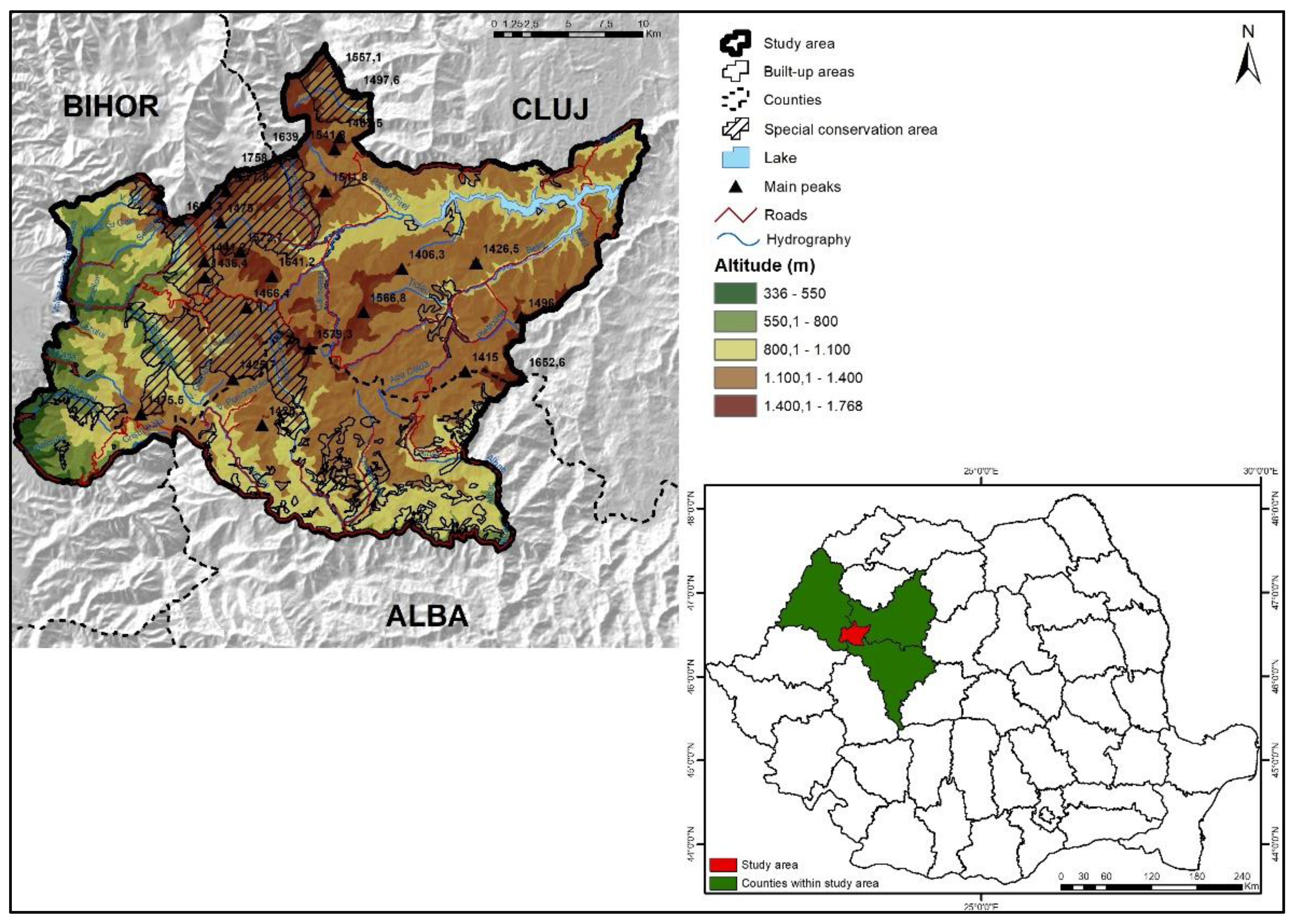

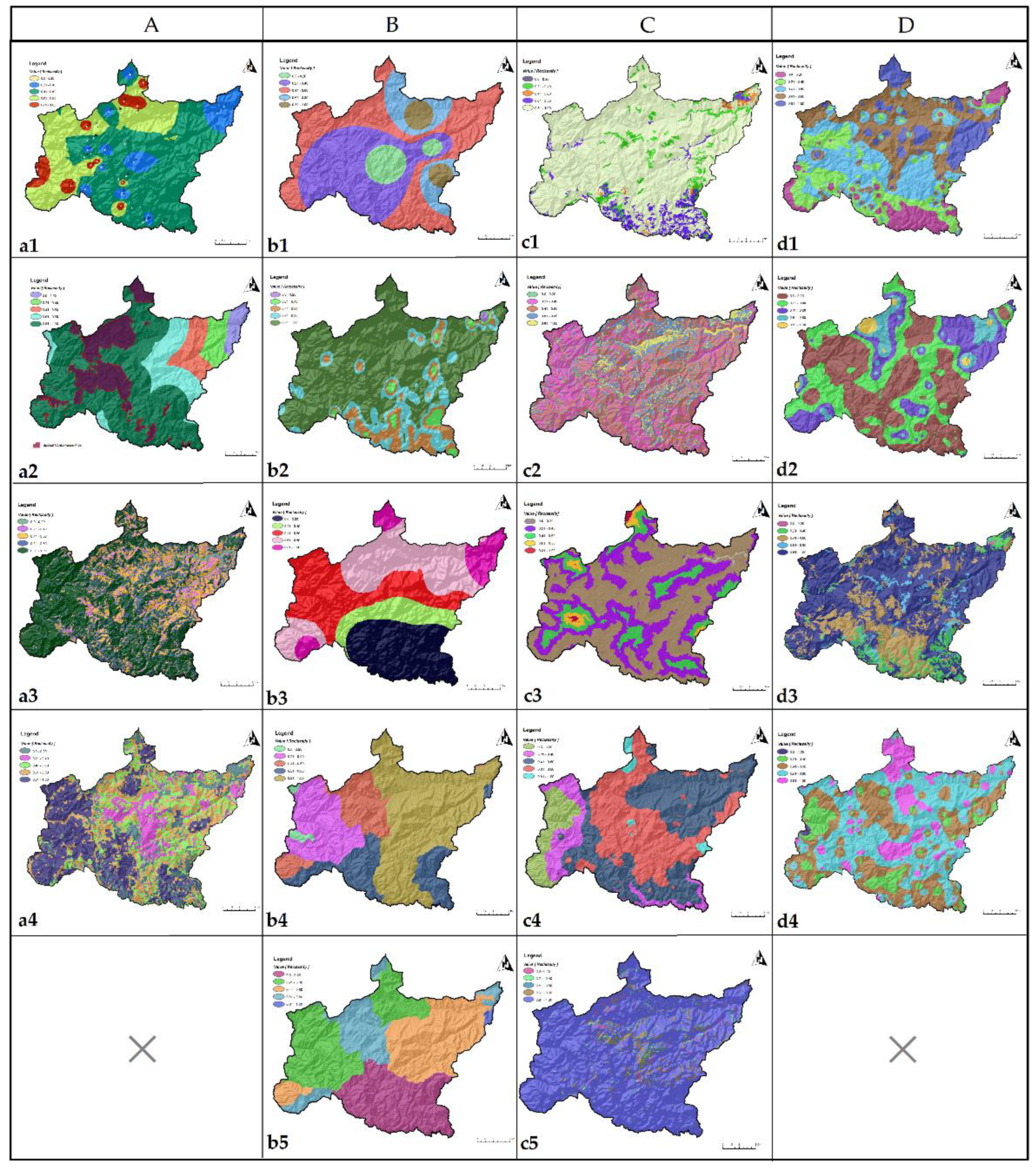
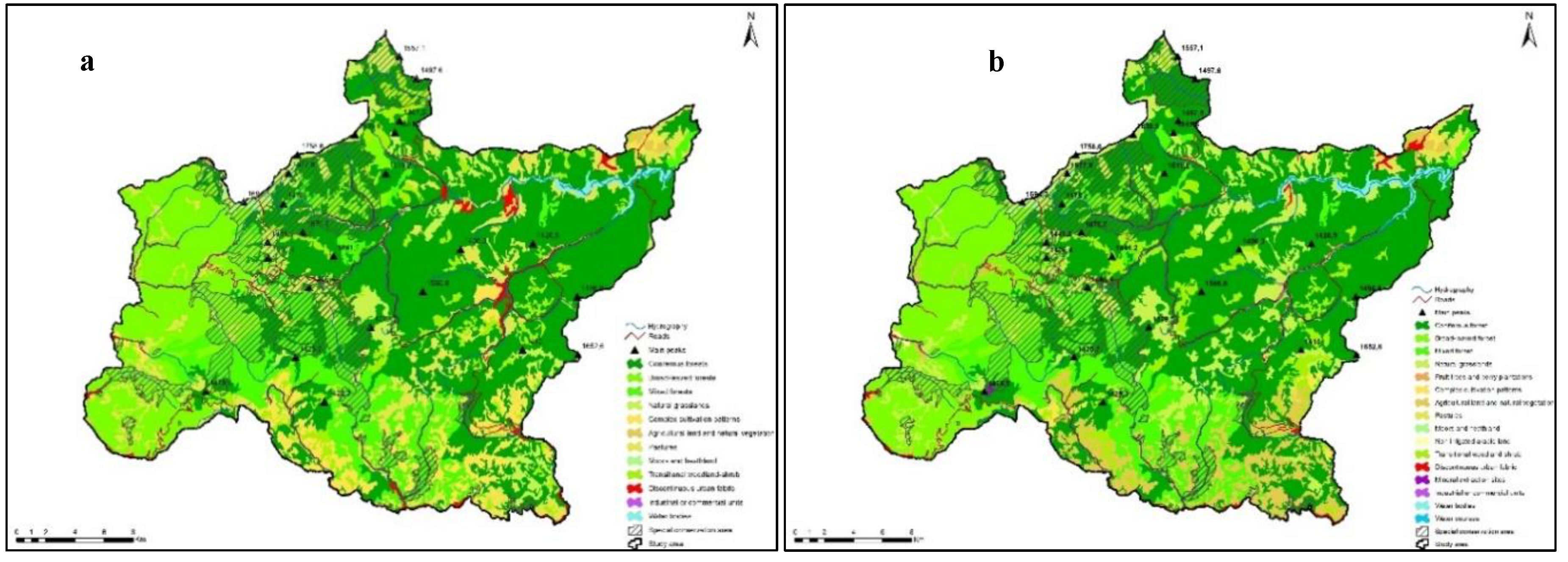

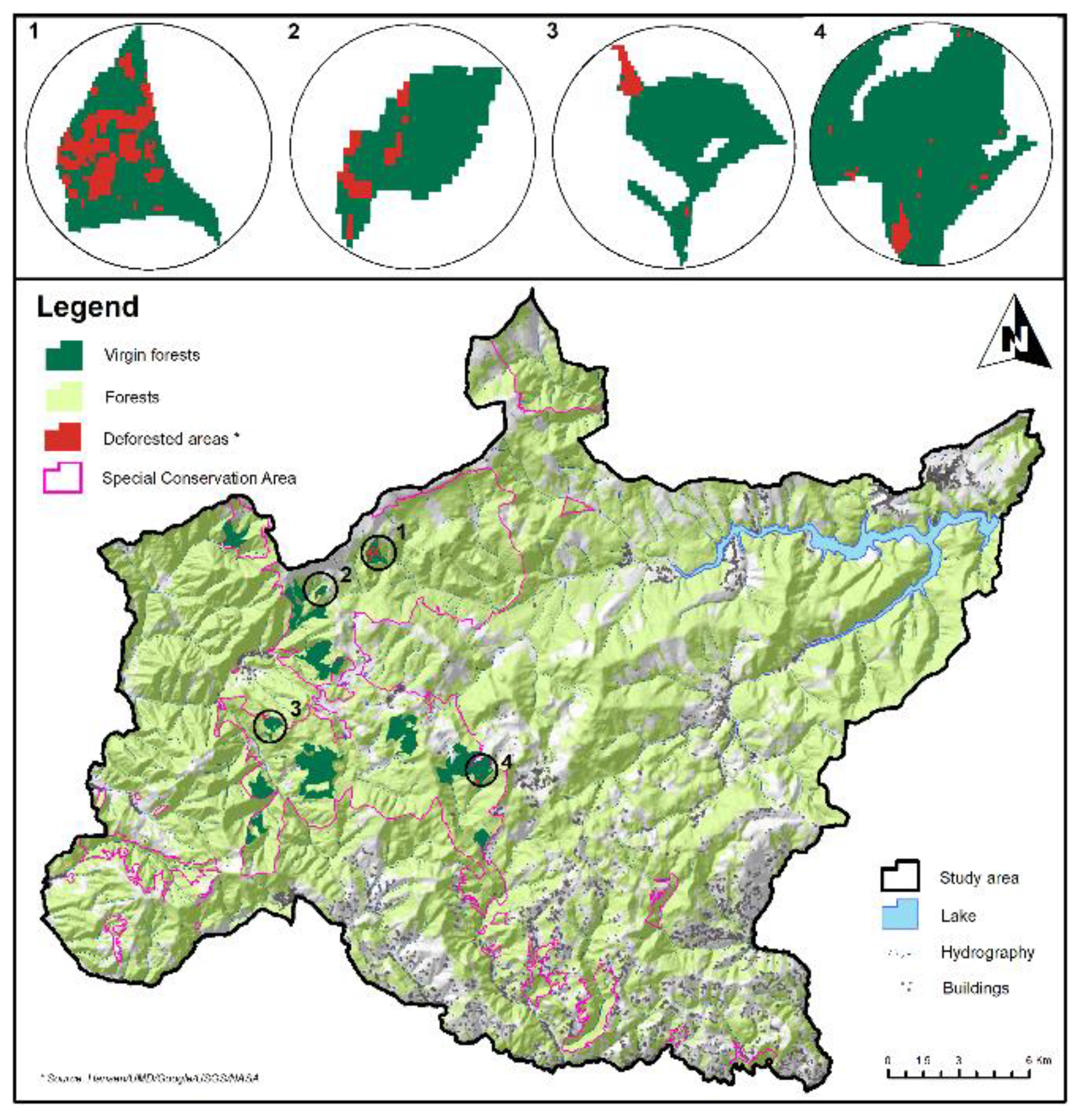
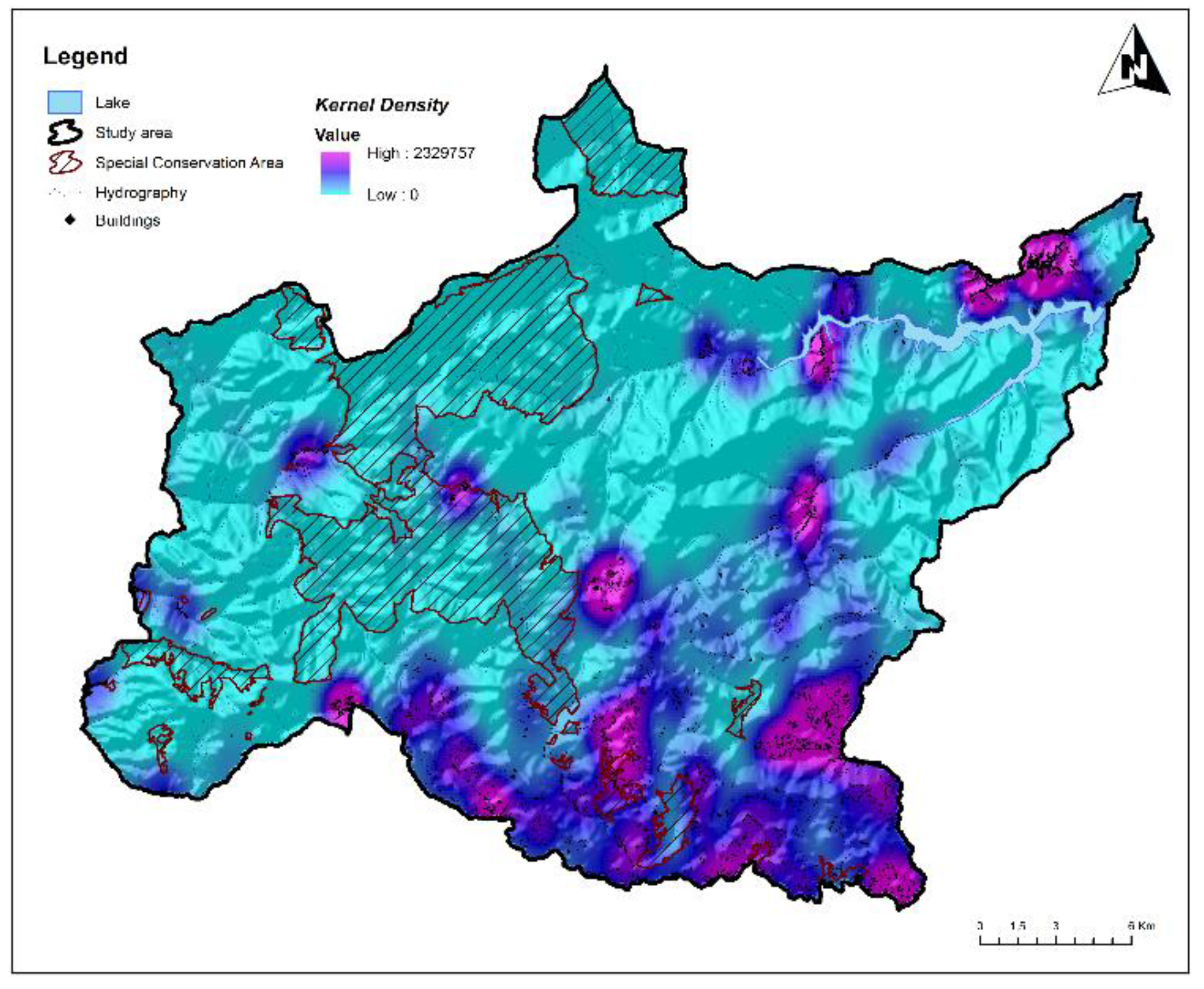
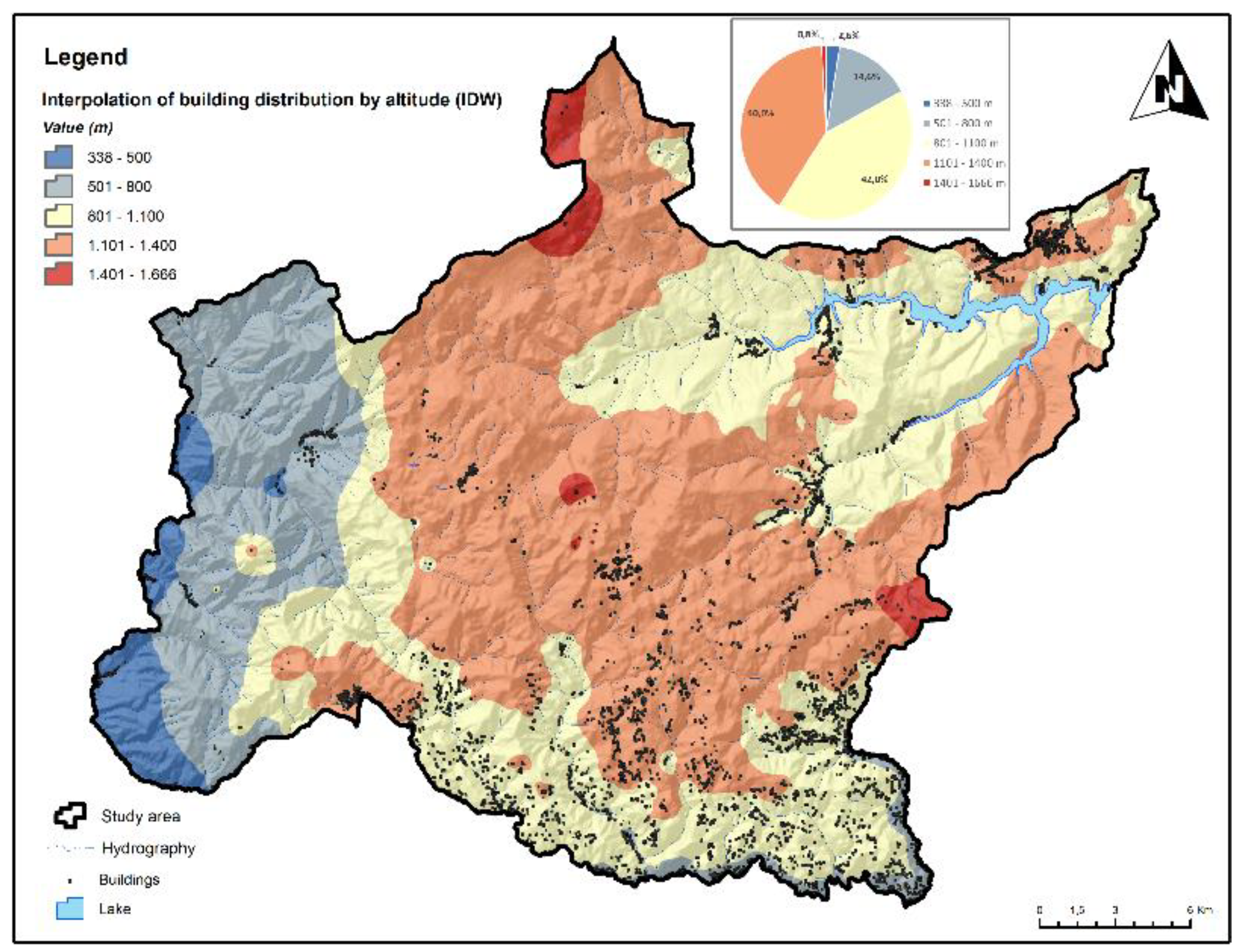
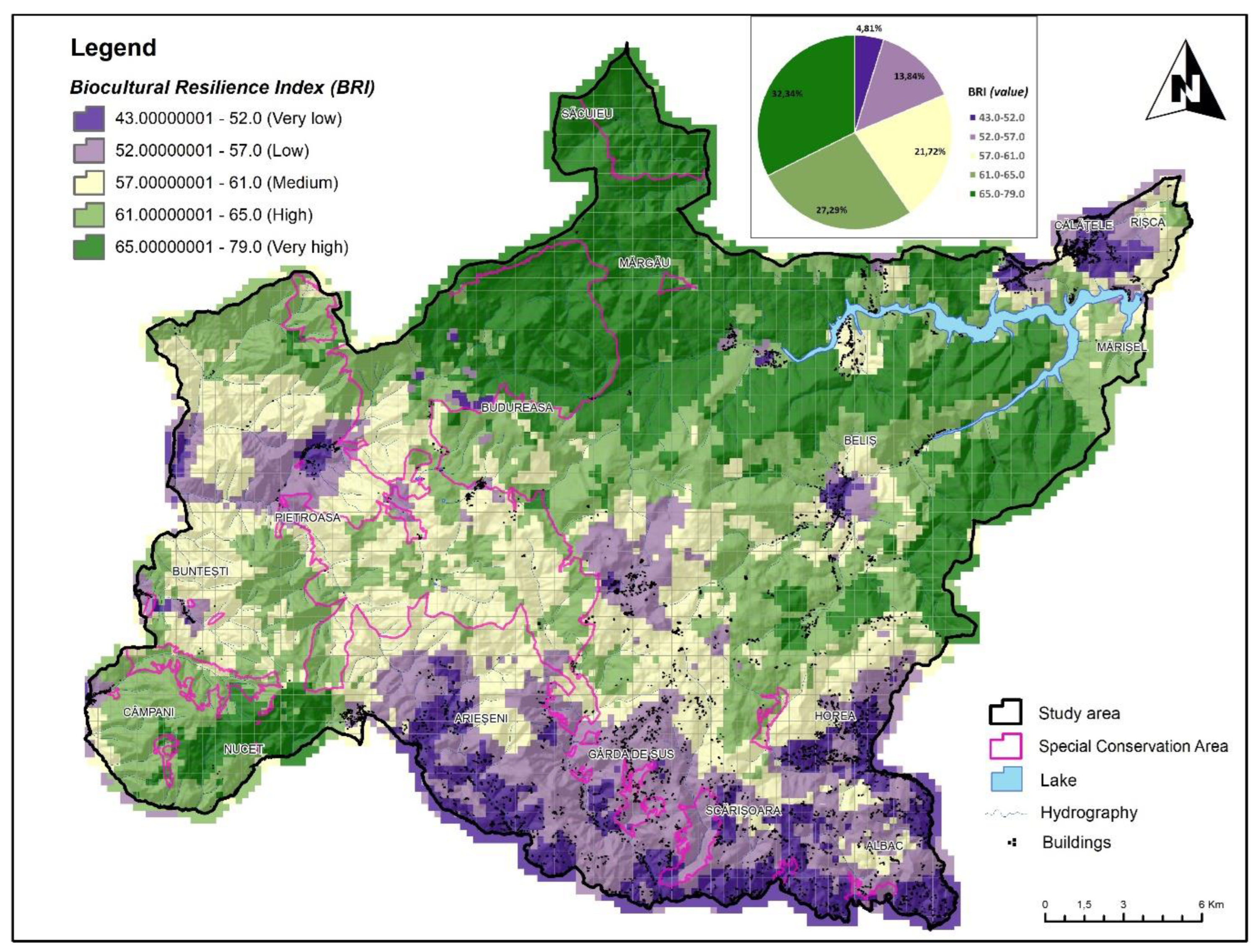
| Date | Mission | ID Sensor | Orbit (path/row) |
|---|---|---|---|
| 08.08.1980 | Landsat 2 | MSS | 200/27 |
| 07.09.1997 | Landsat 5 | TM | 185/28 |
| 17.08.2007 | Landsat 5 | TM | 185/28 |
| 14.08.2023 | Landsat 8 | OLI_TIRS | 185/28 |
| Indicator | Minimum | 2 | 3 | 4 | Maximum | Mean | Standard Deviation |
|---|---|---|---|---|---|---|---|
| A. Natural landscape and biodiversity (Nl-B) | |||||||
| a1. Density of natural monuments | 0.2 | 0.4 | 0.6 | 0.79 | 0.99 | 0.55 | 0.14 |
| a2. Euclidean distance to the special conservation area | 0.01 | 2.117 | 5.988 | 11.465 | 18.622 | 3.241 | 4.242 |
| a3. Normalized difference vegetation index NDVI (2023) | -0.87 | -0.35 | 0.01 | 0.12 | 0.55 | 0.05 | 0.12 |
| a4. Forest landscape integrity index | -9.99 | 2635 | 5142 | 7317 | 9233 | 3541.9 | 6041.2 |
| B. Built heritage and local community (Bh-Lc) | |||||||
| b1. Density of built heritage | 0.20 | 0.30 | 0.38 | 0.47 | 0.59 | 0.37 | 0.07 |
| b2. Building density (Kernel) | 0.01 | 146180.8 | 502496.6 | 1224264.5 | 2329757.2 | 67597.1 | 165124.6 |
| b3. Density of settlement network | 1.0 | 5.73 | 8932 | 12.79 | 17.99 | 8.96 | 3.90 |
| b4. Number of resident population (2021) | 758 | 1008 | 1499 | 2307 | 4090 | 1811.1 | 793.74 |
| b5. Settlement dispersion index | 0.01 | 2.34 | 4.29 | 7.94 | 16.60 | 5.97 | 4.60 |
| C. Land cover/use and spatial accessibility (LCLU-Sa) | |||||||
| c1. Land cover/use | 0.59 | 2.09 | 6.28 | 8.68 | 12.27 | 6.25 | 3.27 |
| c2. Slope | 0.01 | 20.52 | 41.04 | 61.56 | 82.08 | 39.95 | 15.60 |
| c3. Spatial accessibility | 0.01 | 2.03 | 4.07 | 6.10 | 8.14 | 1.36 | 1.16 |
| c4. Altitude of the built environment | 340.3 | 683.5 | 948.6 | 1177.4 | 1666.2 | 1042.9 | 240.81 |
| c5. Forest Cover Loss (2001-2022) | 0.01 | 3.0 | 9.0 | 15.0 | 22.0 | 1.22 | 3.89 |
| D. Landscape metrics (Lm) | |||||||
| d1. Shape index (SI) | 1.66 | 95.44 | 148.12 | 197.65 | 270.35 | 148.58 | 51.79 |
| d2. Forest landscape fragmentation (FRAGSTATS Helper) | 199.44 | 710.69 | 1221.95 | 2116.64 | 4273.50 | 925.87 | 531.91 |
| d3. Plots connectivity | 0.01 | 4.0 | 8.0 | 11.0 | 15.0 | 11.99 | 3.10 |
| d4. Fractal dimension (FD) | 1.0 | 1.10 | 1.14 | 1.28 | 1.67 | 1.12 | 0.03 |
Disclaimer/Publisher’s Note: The statements, opinions and data contained in all publications are solely those of the individual author(s) and contributor(s) and not of MDPI and/or the editor(s). MDPI and/or the editor(s) disclaim responsibility for any injury to people or property resulting from any ideas, methods, instructions or products referred to in the content. |
© 2024 by the authors. Licensee MDPI, Basel, Switzerland. This article is an open access article distributed under the terms and conditions of the Creative Commons Attribution (CC BY) license (http://creativecommons.org/licenses/by/4.0/).





